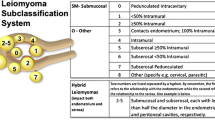Abstract
In the management of women with fibroid disease, GnRH agonists (GnRHa) are frequently used to reduce volume and vascularity before myomectomy, apparently to render the operation easier and reduce operative blood loss, and to enable a transverse supra-pubic incision instead of a midline vertical one. They induce amenorrhoea and thus aid in the correction of pre-operative anaemia. Other gynaecologists use GnRHa to shrink sub mucous fibroids greater than 5 cm in diameter to facilitate access and reduce blood loss and operating time at transcervical resection. GnRHa are also occasionally used as a temporizing measure in women with symptomatic fibroids within the climacteric. We argue against the use of GnRHa in the management of fibroid disease because they are not cost effective, render myomectomy more difficult to apply because they destroy tissue planes, the more difficult enucleation in fact increasing rather than reducing peri-operative blood loss and operating time. When used before myomectomy, they increase the risk of ‘recurrence’ because they obscure smaller fibroids that ‘recur’ when the effects of the GnRHa wear off, and are associated with side effects in situations where they confer no benefits, or where alternative cheaper drugs with fewer side effects are available.
Similar content being viewed by others
References
Filicori M, Hall DA, Loughlin JS, et al. A conservative approach to the management of uterine leiomyoma: pituitary desensitization by a luteinizing hormone-releasing hormone analogue. Am J Obstet Gynecol. 1983;147:726–7.
Maheux R, Guilloteau C, Lemay A, et al. Regression of leiomyomata uteri following hypoestrogenism induced by repetitive LHRH agonist treatment: preliminary report. Fertil Steril. 1984;42:644–6.
Lethaby A, Vollenhoven B, Sowter M. Pre-operative GnRH analogue therapy before hysterectomy or myomectomy for uterine fibroids. Cochrane Database Syst Rev. 2001; (2):CD000547.
Taylor A, Sharma M, Tsirkas P, et al. Surgical and radiological management of uterine fibroids: a UK survey of current consultant practice. Acta Obstet Gynecol Scand. 2005;84:478–82.
Dawood MY, Lewis V, Ramos J. Cortical and trabecular bone mineral content in women with endometriosis: effect of gonadotropin-releasing hormone agonist and danazol. Fertil Steril. 1989;52(1):21–6.
Fukushima M, Shindo M, Sato K. Hormone treatment related bone mineral content changes in Japanese women with endometriosis. Asia Oceania J Obstet Gynaecol. 1993;19(3):299–307.
Matta WH, Shaw RW, Hesp R, et al. Reversible trabecular bone density loss following induced hypo-oestrogenism with the GnRH analogue buserelin in premenopausal women. Clin Endocrinol (Oxf). 1988;29(1):45–51.
Sagsveen M, Farmer JE, Prentice A, et al. Gonadotrophin-releasing hormone analogues for endometriosis: bone mineral density. Cochrane Database Syst Rev. 2003;(4):CD001297.
Lethaby AE, Vollenhoven BJ. An evidence-based approach to hormonal therapies for premenopausal women with fibroids. Best Pract Res Clin Obstet Gynaecol. 2008;22(2):307–31.
British National Formulary No. 61. March, 2011. BMJ Group and RPS Publishing 2010.
Mukhopadhaya N, De Silva C, Manyonda IT. Conventional myomectomy. Best Pract Res Clin Obstet Gynaecol. 2008;22(4):677–705.
ACOG Committee on Practice Bulletins-Gynecology. ACOG practice bulletin. Surgical alternatives to hysterectomy in the management of leiomyomas. Int J Gynaecol Obstet. 2001;73:285–94.
Dubuisson JB, Fauconnier A, Fourchotte V, et al. Laparoscopic myomectomy: predicting the risk of conversion to an open procedure. Hum Reprod. 2001;16:1726–31.
Campo S, Garcea N. Laparoscopic myomectomy in premenopausal women with and without preoperative treatment using gonadotrophin-releasing hormone analogues. Hum Reprod. 1999;14(1):44–8.
Bratby MJ, Belli AM. Radiological treatment of symptomatic uterine fibroids. Best Pract Res Clin Obstet Gynaecol. 2008;22(4):717–34.
Candiani GB, Fedele L, Parazzini F, et al. Risk of recurrence after myomectomy. Br J Obstet Gynaecol. 1991;98(4):385–9.
Vercellini P, Maddalena S, Giorgi OD, et al. Abdominal myomectomy for infertility: a comprehensive review. Hum Reprod. 1998;13:873–9.
Fauconnier A, Chapron C, Babaki-Fard K, et al. Recurrence of leiomyomata after myomectomy. Hum Reprod Update. 2000;6:595–602.
Lethaby A, Vollenhoven B. Fibroids (uterine myomatosis, leiomyomas). Clin Evid. 2002;7:1666–78.
Pritts EA. Fibroids and infertility: a systematic review of the evidence. Obstet Gynecol Surv. 2001;56(8):483–91.
Mencaglia L, Tantini C. GnRH agonist analogs and hysteroscopic resection of myomas. Int J Gynaecol Obstet. 1993;43(3):285–8.
Donnez J, Gillerot S, Bourgonjon D, et al. Neodymium: YAG laser hysteroscopy in large submucous fibroids. Fertil Steril. 1990;54:999–1003.
Emanuel MH, Hart A, Wamsteker K, et al. An analysis of fluid loss during transcervical resection of submucous myomas. Fertil Steril. 1997;68:881–6.
Perino A, Chianchiano N, Petronio M, et al. Role of leuprolide acetate depot in hysteroscopic surgery: a controlled study. Fertil Steril. 1993;59:507–10.
Campo S, Campo V, Gambadauro P. Short-term and long-term results of resectoscopic myomectomy with and without pretreatment with GnRH analogs in premenopausal women. Acta Obstet Gynecol Scand. 2005;84:756–60.
Mavrelos D, Ben-Nagi J, Davies A, et al. The value of pre-operative treatment with GnRH analogues in women with submucous fibroids: a double-blind, placebo-controlled randomized trial. Hum Reprod. 2010;25(9):2264–9.
Muzii L, Boni T, Bellati F, et al. GnRH analogue treatment before hysteroscopic resection of submucous myomas: a prospective, randomized, multicenter study. Fertil Steril. 2010;94(4):1496–9.
NICE guidance: Uterine artery embolisation for fibroids. Interventional procedure guidance 367. National Institute for Health and Clinical Excellence. November, 2010.
Chrisman HB, Saker MB, Ryu RK, et al. The impact of uterine fibroid embolization on resumption of menses and ovarian function. J Vasc Interv Radiol. 2000;11(6):699–703.
Conflicts of interest
None of the authors have any conflicts of interest to declare.
Author information
Authors and Affiliations
Corresponding author
Rights and permissions
About this article
Cite this article
Sinai Talaulikar, V., Belli, AM. & Manyonda, I. GnRH Agonists: Do They Have a Place in the Modern Management of Fibroid Disease?. J Obstet Gynecol India 62, 506–510 (2012). https://doi.org/10.1007/s13224-012-0206-0
Received:
Accepted:
Published:
Issue Date:
DOI: https://doi.org/10.1007/s13224-012-0206-0




